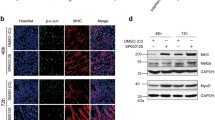Abstract
Skeletal muscle differentiation is a highly coordinated process that involves many cellular signaling pathways and microRNAs (miRNAs). A group of muscle-specific miRNAs has been reported to promote myogenesis by suppressing key signaling pathways for cell growth. However, the functional role and regulatory mechanism of most non-muscle-specific miRNAs with stage-specific changes during differentiation are largely unclear. Here, we describe the functional characterization of miR-101a/b, a pair of non-muscle-specific miRNAs that show the largest change among a group of transiently upregulated miRNAs during myogenesis in C2C12 cells. The overexpression of miR-101a/b inhibits myoblast differentiation by suppressing the p38/MAPK, Interferon Gamma, and Wnt pathways and enhancing the C/EBP pathway. Mef2a, a key protein in the p38/MAPK pathway, was identified as a direct target of miR-101a/b. Interestingly, we found that the long non-coding RNA (lncRNA) Malat1, which promotes muscle differentiation, interacts with miR-101a/b, and this interaction competes with Mef2a mRNA to relieve the inhibition of the p38/MAPK pathway during myogenesis. These results uncovered a “braking” role in differentiation of transiently upregulated miRNAs and provided new insights into the competing endogenous RNA (ceRNA) regulatory mechanism in myoblast differentiation and myogenesis.
Similar content being viewed by others

References
Abraham, S.T. (2016). A role for the Wnt3a/β-catenin signaling pathway in the myogenic program of C2C12 cells. In Vitro Cell Dev Biol Anim 52, 935–941.
Callis, T.E., Deng, Z., Chen, J.F., and Wang, D.Z. (2008). Muscling through the microRNA world. Exp Biol Med (Maywood) 233, 131–138.
Cesana, M., Cacchiarelli, D., Legnini, I., Santini, T., Sthandier, O., Chinappi, M., Tramontano, A., and Bozzoni, I. (2011). A long noncoding RNA controls muscle differentiation by functioning as a competing endogenous RNA. Cell 147, 358–369.
Elia, L., Contu, R., Quintavalle, M., Varrone, F., Chimenti, C., Russo, M. A., Cimino, V., De Marinis, L., Frustaci, A., Catalucci, D., et al. (2009). Reciprocal regulation of microRNA-1 and insulin-like growth factor-1 signal transduction cascade in cardiac and skeletal muscle in physiological and pathological conditions. Circulation 120, 2377–2385.
Fan, Y., Shen, B., Tan, M., Mu, X., Qin, Y., Zhang, F., and Liu, Y. (2014). TGF-β-induced upregulation of malat1 promotes bladder cancer metastasis by associating with suz12. Clin Cancer Res 20, 1531–1541.
Guicheux, J., Lemonnier, J., Ghayor, C., Suzuki, A., Palmer, G., and Caverzasio, J. (2003). Activation of p38 mitogen-activated protein kinase and c-Jun-NH2-terminal kinase by BMP-2 and their implication in the stimulation of osteoblastic cell differentiation. J Bone Miner Res 18, 2060–2068.
Han, X., Yang, F., Cao, H., and Liang, Z. (2015). Malat1 regulates serum response factor through miR-133 as a competing endogenous RNA in myogenesis. FASEB J 29, 3054–3064.
Hirata, H., Hinoda, Y., Shahryari, V., Deng, G., Nakajima, K., Tabatabai, Z. L., Ishii, N., and Dahiya, R. (2015). Long noncoding RNA MALAT1 promotes aggressive renal cell carcinoma through Ezh2 and interacts with miR-205. Cancer Res 75, 1322–1331.
Huang, M.B., Xu, H., Xie, S.J., Zhou, H., and Qu, L.H. (2011). Insulin-like growth factor-1 receptor is regulated by microRNA-133 during skeletal myogenesis. PLoS ONE 6, e29173.
Humphreys, D.T., Westman, B.J., Martin, D.I.K., and Preiss, T. (2005). MicroRNAs control translation initiation by inhibiting eukaryotic initiation factor 4E/cap and poly(A) tail function. Proc Natl Acad Sci USA 102, 16961–16966.
Kallen, A.N., Zhou, X.B., Xu, J., Qiao, C., Ma, J., Yan, L., Lu, L., Liu, C., Yi, J.S., Zhang, H., et al. (2013). The imprinted H19 lncRNA antagonizes let-7 microRNAs. Mol Cell 52, 101–112.
Lamon, S., Zacharewicz, E., Butchart, L.C., Orellana, L., Mikovic, J., Grounds, M.D., and Russell, A.P. (2017). MicroRNA expression patterns in post-natal mouse skeletal muscle development. BMC Genomics 18, 52.
Li, J.H., Liu, S., Zhou, H., Qu, L.H., and Yang, J.H. (2014). starBase v2.0: decoding miRNA-ceRNA, miRNA-ncRNA and protein-RNA interaction networks from large-scale CLIP-Seq data. Nucl Acids Res 42, D92–D97.
Liao, K., Lin, Y., Gao, W., Xiao, Z., Medina, R., Dmitriev, P., Cui, J., Zhuang, Z., Zhao, X., Qiu, Y., et al. (2019). Blocking lncRNA MALAT1/miR-199a/ZHX1 axis inhibits glioblastoma proliferation and progression. Mol Ther Nucleic Acids 18, 388–399.
Liu, S., Li, B., Liang, Q., Liu, A., Qu, L., and Yang, J. (2020). Classification and function of RNA-protein interactions. WIREs RNA 11.
Lluís, F., Perdiguero, E., Nebreda, A.R., and Muñoz-Cánoves, P. (2006). Regulation of skeletal muscle gene expression by p38 MAP kinases. Trends Cell Biol 16, 36–44.
Luan, W., Li, L., Shi, Y., Bu, X., Xia, Y., Wang, J., Djangmah, H.S., Liu, X., You, Y., and Xu, B. (2016). Long non-coding RNA MALAT1 acts as a competing endogenous RNA to promote malignant melanoma growth and metastasis by sponging miR-22. Oncotarget 7, 63901–63912.
Marchildon, F., Lala, N., Li, G., St-Louis, C., Lamothe, D., Keller, C., and Wiper-Bergeron, N. (2012). CCAAT/enhancer binding protein beta is expressed in satellite cells and controls myogenesis. Stem Cells 30, 2619–2630.
McCarthy, J.J., and Esser, K.A. (2007). MicroRNA-1 and microRNA-133a expression are decreased during skeletal muscle hypertrophy. J Appl Physiol 102, 306–313.
Miller, J.B. (1990). Myogenic programs of mouse muscle cell lines: expression of myosin heavy chain isoforms, MyoD1, and myogenin.. J Cell Biol 111, 1149–1159.
Nusse, R. (2008). Wnt signaling and stem cell control. Cell Res 18, 523–527.
Pillai, R.S., Bhattacharyya, S.N., Artus, C.G., Zoller, T., Cougot, N., Basyuk, E., Bertrand, E., and Filipowicz, W. (2005). Inhibition of translational initiation by Let-7 microRNA in human cells. Science 309, 1573–1576.
Rinkenbaugh, A.L., and Baldwin, A.S. (2016). The NF-κB pathway and cancer stem cells. Cells 5, 16.
Saw, P.E., Xu, X., Chen, J., and Song, E.W. (2020). Non-coding RNAs: the new central dogma of cancer biology. Sci China Life Sci, doi: https://doi.org/10.1007/s11427-020-1700-9.
Small, E.M., O’Rourke, J.R., Moresi, V., Sutherland, L.B., McAnally, J., Gerard, R.D., Richardson, J.A., and Olson, E.N. (2010). Regulation of PI3-kinase/Akt signaling by muscle-enriched microRNA-486. Proc Natl Acad Sci USA 107, 4218–4223.
Song, T. F., Huang, L. W., Yuan, Y., Wang, H. Q., He, H. P., Ma, W. J., Huo, L. H., Zhou, H., Wang, N., and Zhang, T.C. (2018). LncRNA MALAT1 regulates smooth muscle cell phenotype switch via activation of autophagy. Oncotarget 9, 4411–4426.
Sun, Q., Hao, Q., and Prasanth, K.V. (2018). Nuclear long noncoding RNAs: key regulators of gene expression. Trends Genets 34, 142–157.
van Rooij, E., Liu, N., and Olson, E.N. (2008). MicroRNAs flex their muscles. Trends Genets 24, 159–166.
van Rooij, E., Quiat, D., Johnson, B.A., Sutherland, L.B., Qi, X., Richardson, J.A., Kelm Jr., R.J., and Olson, E.N. (2009). A family of microRNAs encoded by myosin genes governs myosin expression and muscle performance. Dev Cell 17, 662–673.
Wang, L.Q., Yu, P., Li, B., Guo, Y.H., Liang, Z.R., Zheng, L.L., Yang, J.H., Xu, H., Liu, S., Zheng, L.S., et al. (2018). miR-372 and miR-373 enhance the stemness of colorectal cancer cells by repressing differentiation signaling pathways. Mol Oncol 12, 1949–1964.
Wang, X., Li, M., Wang, Z., Han, S., Tang, X., Ge, Y., Zhou, L., Zhou, C., Yuan, Q., and Yang, M. (2015). Silencing of long noncoding RNA MALAT1 by miR-101 and miR-217 inhibits proliferation, migration, and invasion of esophageal squamous cell carcinoma cells. J Biol Chem 290, 3925–3935.
Wang, Y., Zhang, Y., Yang, T., Zhao, W., Wang, N., Li, P., Zeng, X., and Zhang, W. (2017) Long non-coding RNA MALAT1 for promoting metastasis and proliferation by acting as a ceRNA of miR-144-3p in osteosarcoma cells. Oncotarget 8, 59417–59434.
Xie, S.J., Zhang, Y., Qu, L.H., and Xu, H. (2013). A Helm model for microRNA regulation in cell fate decision and conversion. Sci China Life Sci 56, 897–906.
Xie, S.J., Li, J.H., Chen, H.F., Tan, Y.Y., Liu, S.R., Zhang, Y., Xu, H., Yang, J.H., Liu, S., Zheng, L.L., et al. (2018). Inhibition of the JNK/MAPK signaling pathway by myogenesis-associated miRNAs is required for skeletal muscle development. Cell Death Differ 25, 1581–1597.
Xu, H., Xu, S.J., Xie, S.J., Zhang, Y., Yang, J.H., Zhang, W.Q., Zheng, M. N., Zhou, H., and Qu, L.H. (2019). MicroRNA-122 supports robust innate immunity in hepatocytes by targeting the RTKs/STAT3 signaling pathway. eLife 8, e41159.
Xue, Y., Chen, R., Qu, L., and Cao, X. (2020). Noncoding RNA: from dark matter to bright star. Sci China Life Sci 63, 463–468.
Yang, L., Lin, C., Liu, W., Zhang, J., Ohgi, K.A., Grinstein, J.D., Dorrestein, P.C., and Rosenfeld, M.G. (2011). ncRNA- and Pc2 methylation-dependent gene relocation between nuclear structures mediates gene activation programs. Cell 147, 773–788.
Yu, F., Lu, Z., Cai, J., Huang, K., Chen, B., Li, G., Dong, P., and Zheng, J. (2015). MALAT1 functions as a competing endogenous RNA to mediate Rac1 expression by sequestering miR-101b in liver fibrosis. Cell Cycle 14, 3885–3896.
Zhang, X., Zuo, X., Yang, B., Li, Z., Xue, Y., Zhou, Y., Huang, J., Zhao, X., Zhou, J., Yan, Y., et al. (2014) MicroRNA directly enhances mitochondrial translation during muscle differentiation. Cell 158, 607–619.
Zhang, Y., and Li, Y.K. (2013). Regulation of innate receptor pathways by microRNAs. Sci China Life Sci 56, 13–18.
Zhao, M., New, L., Kravchenko, V.V., Kato, Y., Gram, H., di Padova, F., Olson, E.N., Ulevitch, R.J., and Han, J. (1999). Regulation of the MEF2 family of transcription factors by p38. Mol Cell Biol 19, 21–30.
Acknowledgements
The authors thank Qiao-Juan Huang and Xiao-Hong Chen for their technical assistance. This work was supported by the National Natural Science Foundation of China (31970604, 31701116, 31770879, 31771459, 31900903, 81870449, 81974436), the Major Research Plan of the National Natural Science Foundation of China (91940000), the Fundamental Research Funds for the Central Universities (20lgpy112), and Science and Technology New Star in ZhuJiang Guangzhou City (201806010151).
Author information
Authors and Affiliations
Corresponding authors
Additional information
Compliance and ethics
The author(s) declare that they have no conflict of interest.
Rights and permissions
About this article
Cite this article
Liu, S., Xie, S., Chen, H. et al. The functional analysis of transiently upregulated miR-101 suggests a “braking” regulatory mechanism during myogenesis. Sci. China Life Sci. 64, 1612–1623 (2021). https://doi.org/10.1007/s11427-020-1856-5
Received:
Accepted:
Published:
Issue Date:
DOI: https://doi.org/10.1007/s11427-020-1856-5



